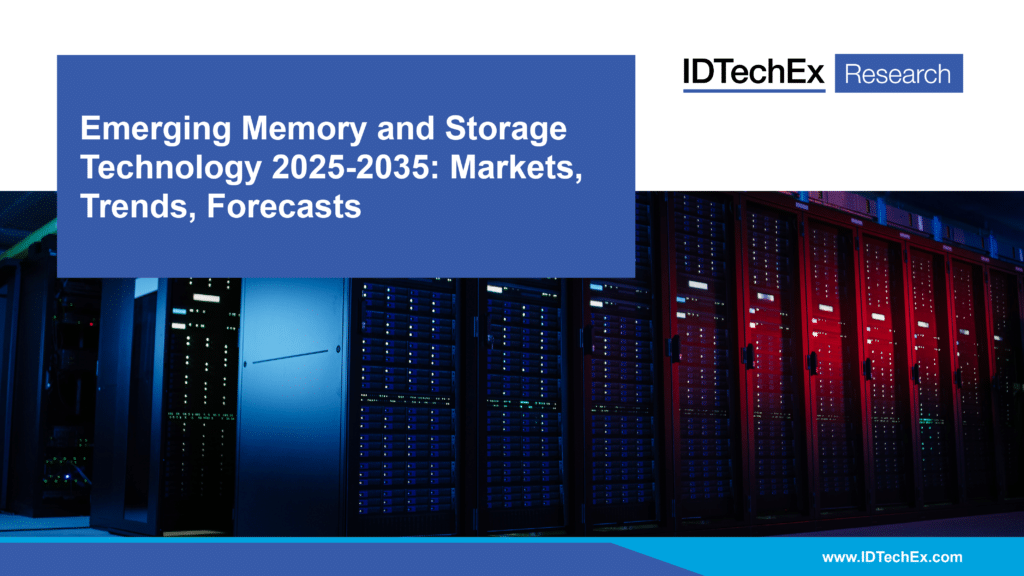For more information, visit https://www.idtechex.com/en/research-report/emerging-memory-and-storage-technology-2025-2035-markets-trends-forecasts/1088.
Yearly market size for memory & storage market will exceed $300B by 2035
The explosion of AI and HPC workloads, the rising demand for data centers and cloud storage, and the expansion of IoT and edge computing are driving the need for next-generation memory and storage solutions, as well as the adoption of emerging memory technologies. IDTechEx’s report, “Emerging Memory and Storage Technology 2025-2035: Markets, Trends, Forecasts”, examines key technologies shaping the future of memory and storage, including SSDs (SLC, TLC, and QLC), HDDs, and emerging memory solutions such as Magnetoresistive RAM (MRAM), Resistive RAM (ReRAM/RRAM), Ferroelectric RAM (FeRAM), and Phase-Change Memory (PCM). The report also analyzes current and emerging market trends, provides an outlook for each technology, and highlights new commercial opportunities.
Key Trends in Memory and Storage
The current memory and storage market is built on three dominant technologies: HDDs, SSDs, and DRAM. SSDs are increasingly replacing HDDs in many applications due to their higher performance and lower latency. However, HDDs remain essential for high-capacity storage. The introduction of Quad-Level Cell (QLC) SSDs is reshaping storage hierarchies, offering the highest density of any SSD while outperforming HDDs in speed and endurance.
As AI and HPC workloads demand greater performance, studies show that switching from traditional tiered storage (TLC SSDs for hot data and HDDs for cold data) to QLC SSDs can significantly reduce costs. A 10PB QLC SSD-based storage system is estimated to provide US$30.3 million in savings over 10 years, with a 47% reduction in total cost of ownership (TCO) over five years due to lower rack space, power consumption, and maintenance costs. This shift is particularly relevant for AI, HPC, and cloud applications, which rely on high-speed, high-density storage.
AI/HPC workloads require high bandwidth for parallel processing applications but face challenges due to memory bottlenecks—known as the memory wall—caused by processor advancements outpacing memory bandwidth. For example, large language models (LLMs) used in generative AI often experience less than 50% of peak processor performance due to these constraints. Solutions such as High Bandwidth Memory (HBM), which vertically stacks DRAM chips, are being adopted to increase data throughput. Emerging non-volatile memory (NVM) solutions, such as MRAM, are also being explored for storage-class memory (SCM) applications.
In embedded memory applications, NOR Flash currently dominates, but it faces limitations in performance, endurance, and scalability. NOR Flash struggles to scale below 28nm, making it incompatible with advanced CMOS processes for microcontroller (MCU) manufacturing. This has created an opportunity for emerging NVM solutions like ReRAM and MRAM, which can scale below 10nm. Companies like Everspin have already gained traction in this space, while major players such as TSMC, GlobalFoundries, and Samsung are integrating emerging NVM into their platforms.
IDTechEx’s report “Emerging Memory and Storage Technology 2025-2035: Markets, Trends, Forecasts” projects that the market size for memory and storage technologies will double, with emerging memory technologies expected to grow 2.2 times their current size over this period.
 Memory and Storage Market by Application. For full data, refer to “Emerging Memory and Storage Technology 2025-2035: Markets, Trends, Forecasts”.
Memory and Storage Market by Application. For full data, refer to “Emerging Memory and Storage Technology 2025-2035: Markets, Trends, Forecasts”.
 Emerging Memory Market by Technology. For full data, refer to “Emerging Memory and Storage Technology 2025-2035: Markets, Trends, Forecasts”.
Emerging Memory Market by Technology. For full data, refer to “Emerging Memory and Storage Technology 2025-2035: Markets, Trends, Forecasts”.
For those looking to understand the evolving memory and storage landscape, including key trends, emerging technologies, and market outlooks, IDTechEx’s report provides a detailed assessment of the industry’s future. The growth of AI/HPC, cloud storage, and edge computing is driving demand for high-capacity, high-performance storage and low power, next-generation and emerging memory solutions.
As such, “Emerging Memory and Storage Technology 2025-2035: Markets, Trends, Forecasts” provides comprehensive 10-year forecasts not only for the overall memory and storage market but also for key hardware technologies, including HDDs, SSDs, and DRAM, as well as major application areas. In addition, it provides forecasts for the emerging memory sector, covering key technologies such as MRAM, ReRAM, FeRAM, and PCM. Readers will gain a deep understanding of the present and future of the industry, equipping them with the insights needed to make informed strategic decisions.


